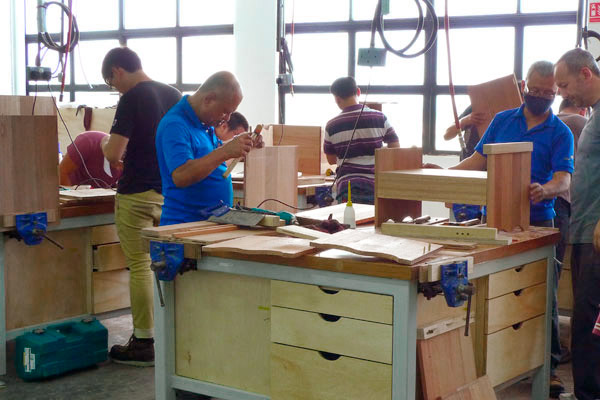In response to the growing shortage of well-equipped local carpenters, Singapore’s first carpentry training facility has opened up in Yishun to nurture an industry of skillful and knowledgeable creative craftsmen, writes Stephanie Peh.

December 4th, 2014
Spanning 4,500 square feet, Singapore’s first carpentry training campus in Yishun comprises two classrooms and a workshop. The facility mirrors the stringent training conditions of the Polytechnic of Western Australia (PWA), which includes certified trainers, high level safety, possession of specific machines, hand and power tools, as well as comfortable space in between machines and around the workshop, all of which are approved by the PWA.
A tripartite effort by the SFIC Institute (SFICI), National Trades Union Congress’ e2i (Employment and Employability Institute) and the Singapore Workforce Development Agency (WDA), the centre is also supported by the Singapore Furniture Industries Council (SFIC) and SPRING Singapore.
A six-month long training course titled “Creative Craftsman Apprenticeship Programme” has been customised for Singaporeans and Permanent Residents interested to embark on a career in woodworking. While the training is useful in building adequate foundation, graduates will require further training and experience in the actual workforce to heighten their newly acquired skillsets and knowledge. As such, the train-and-place model implemented will allow graduates to work under an employer, who will also bear the cost of the training. With no age limit, the course is accessible to physically fit and aspiring carpenters.

Apprentices working on their coffee table project
“The syllabus comprises a 12-day induction programme, and a 10-week carpentry skills workshop interspersed with on-the-job training and mentorship sessions with their new employers, to ensure a seamless eventual transition to the workforce,” explains Mr Neo Sia Meng, SFIC Vice President and Chairman of SFIC Institute. Modules have been purposefully tailored to respond to the requirements of the industry. Trainees are taught safety procedures, skills and techniques, machine operation and maintenance, as well as efficient preparation processes, corresponding to the ins and outs of the furniture making process.
To create a wholesome curriculum, “apprentices are also taught how to apply teamwork in the workplace, make measurements, read and interpret work documents, and learn the principles of design and engineering drawings,” Mr Neo adds. This aligns to the goal of nurturing a breed of ‘Creative Craftsmen’ who he says, “appreciate design and take great pride in their craftsmanship to create functional products.”

A showcase of basic joinery techniques done by the apprentices
Trainers employed by the SFIC Institute are industry practitioners experienced in the field of carpentry and design. To further enforce training quality, they too, must also undergo a structural training programme conducted by the PWA.
Mr Neo recognises that the strong economic growth of countries in Asia has attributed to a boom in the hospitality industry. “More than 220,000 first-class or luxury hotel rooms are expected to be built across China and the ASEAN region in the next 12 months,” he states. While there is opportunity in the emerging market, the labour-intensive small and medium enterprises (SMEs) in the furniture contract sector face the challenge of hiring local manpower. The industry is currently heavily reliant on old retiring craftsmen or foreign labour who may not always be equipped with relevant skillsets.
“The lack of a competent workforce is a challenge when it comes to maintaining a company’s productivity and competitiveness,” explains Mr Neo. This problem persists due to the lack of adequate and accessible training facilities with a comprehensive curriculum. Furthermore, general public misconception on poor career progression in the field of carpentry, especially amongst young Singaporeans, aggravates the issue. The institute aims to inject fresh perspective, and in the long run increase the output of skilled and passionate creative craftsmen, creating a new standard of locally manufactured furniture.
Before joining the industry, Mr Muhammad Iszad Bin Razali, 27, was a crane maintenance technician with a longstanding passion in woodcraft. “During my secondary school years, there was a Design and Technology subject in school, and that was the only experience I had [in woodworking]. There were no other opportunities for me to pursue woodworking as a profession,” he laments. Mr Muhammad is now employed by Arthur Zaaro Design LLP. When asked for his advice to aspiring apprentices, he simply shares, “Just enjoy the work.”
A searchable and comprehensive guide for specifying leading products and their suppliers
Keep up to date with the latest and greatest from our industry BFF's!

Create a configuration to suit your needs with this curved collection.

Marylou Cafaro’s first trendjournal sparked a powerful, decades-long movement in joinery designs and finishes which eventually saw Australian design develop its independence and characteristic style. Now, polytec offers all-new insights into the future of Australian design.

Channelling the enchanting ambience of the Caffè Greco in Rome, Budapest’s historic Gerbeaud, and Grossi Florentino in Melbourne, Ross Didier’s new collection evokes the designer’s affinity for café experience, while delivering refined seating for contemporary hospitality interiors.

The Workshopped ‘Design In Architecture’ exhibition has opened in Sydney, and this year celebrates 15 years of showcasing design talent.

The upcoming issue of Habitus features contributions from two exciting personalities, Elizabeth Farrelly and Amanda Talbot.
The internet never sleeps! Here's the stuff you might have missed

An entry by MuseLAB, in The Retail Space in the 2024 INDE.Awards, takes shoppers to another planet where diamonds and great interior design make a lasting impression.

By adding Muuto to its roster as Singapore’s only retailer, XTRA not only celebrates the enduring appeal of Scandinavian design – it heralds a whole new perspective on its universally appealing legacy.

Adaptive reuse is all the rage across the design industry, and rightly so. Here, we present a selection of articles on this most effective approach to sustainability.

In the pursuit of an uplifting synergy between the inner world and the surrounding environment, internationally acclaimed Interior Architect and Designer Lorena Gaxiola transform the vibration of the auspicious number ‘8’ into mesmerising artistry alongside the Feltex design team, brought to you by GH Commercial.